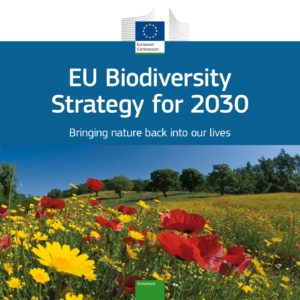 The new European Biodiversity Strategy for 2030, presented in May 2020, set new objectives for the protection of biodiversity in the European Union. Among these objectives, the strategy sets the target of achieving 30% of protected lands (an increase of 4% compared to 2020) and 10% of strictly protected areas (compared to 3% in 2020). The European Commission’s will to further protect areas of high environmental value and vulnerable in the face of climate change has an impact on mountain territories, considering that 43% of Natura 2000 areas are for example currently located in mountainous areas.
The new European Biodiversity Strategy for 2030, presented in May 2020, set new objectives for the protection of biodiversity in the European Union. Among these objectives, the strategy sets the target of achieving 30% of protected lands (an increase of 4% compared to 2020) and 10% of strictly protected areas (compared to 3% in 2020). The European Commission’s will to further protect areas of high environmental value and vulnerable in the face of climate change has an impact on mountain territories, considering that 43% of Natura 2000 areas are for example currently located in mountainous areas.
How will these new protected areas be selected, what activities will be allowed in the strictly protected areas and what will be the implications for mountain people? Some answers are available in the document published on 28 January 2022 by the European Commission, which provides guidelines to the States.
What is and is not allowed in strictly protected areas?
The 10% of strictly protected areas are a subset of the 30% protected areas target, meaning that strictly protected areas will apply the conservation conditions applicable to protected areas as well as additional and more restrictive preservation measures. According to the European Commission, these strictly protected areas must be territories “particularly rich in biodiversity and must be left untouched by human activity”. Yet, in these so called “non-intervention areas”, some limited activities should remain authorized if they do not interfere with the natural processes or if they enhance them. Such activities include:
- Scientific research,
- Natural disaster prevention (like measures to prevent wildfires, such as the actions that will be carried out through our Horizon 2020 project FIRE-RES),
- Invasive alien species control,
- Non-intrusive activities and installations,
- Non-intrusive and strictly controlled recreational activities. In the views of the European Commission, such activities should however be in line with the conservation targets of the area and should be subject to a case-by-case assessment,
- Mowing or grazing of grasslands is being recognized by the European Commission as a human intervention that contributes to preserving and enhancing habitats. However, the guidelines also point out that grazing should be allowed if limited to the intensity needed to preserve the grasslands in question. This underlines the importance of sustainable grassland management, as demonstrated by the LIFE project OREKA MENDIAN in its good practices’ booklet and recommendations.
Next steps
Euromontana welcomes the guidelines drawn up by the European Commission and is pleased that strictly protected areas do not ban all human activity. In many mountain areas, the absence of human activity like pastoralism would lead to a rewilding trend that could damage local habitats and species and could lead to a loss of ecosystem services (prevention against avalanches or rock fall, carbon sequestration for instance).
In addition, mountains remain rich in biodiversity and landscapes. Hence, it is essential that local communities and visitors can enjoy their landscapes without causing harm to the environment. Some mountain areas face particular challenges such as over-tourism, which can affect species reproduction, habitat conservation and soil erosion. Euromontana thus welcomes the possibility of limited and controlled recreational activities in strictly protected areas.
The European Commission’s guidelines, however, remain non-binding recommendations for the Member States. Euromontana therefore calls upon Member States to act in concertation with regional and local authorities and with local communities to define these new protected and strictly protected areas in order to avoid any conflicts in the use of these lands.
2 February 2022









